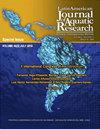亚热带河口和邻近大陆架底层鱼类空间变异的环境因素
IF 0.8
4区 农林科学
Q3 FISHERIES
Latin American Journal of Aquatic Research
Pub Date : 2023-02-28
DOI:10.3856/vol51-issue1-fulltext-2956
引用次数: 0
摘要
2014年至2018年间,在邻近大陆架和巴拉那瓜河口综合体(PEC)进行了每季度的底层鱼类采集。单变量和多变量统计分析用于确定底层鱼类组合的丰度、丰富度和组成,并通过应用广义线性模型列出导致这些生态描述符变异的预测变量。所收集的底栖鱼类标本(n=25179)分布在19目、31科和72种中。鱼类丰富度由以下预测变量解释:沉积物中细沙的百分比、底栖巨型动物的丰富度和采样点。丰度与沉积物中极细砂的百分比、沉积物中淤泥的百分比、盐度和采样地点等预测变量有关。典型对应分析表明,鱼类群落组成与盐度梯度密切相关,与底栖大型动物物种丰富度呈正相关。由于它是联合国教科文组织宣布为人类自然遗产的大西洋森林的最后遗迹之一,本研究中观察到的模式将支持PEC对当前发展需求的沿海管理,特别是与港口活动有关的需求。本文章由计算机程序翻译,如有差异,请以英文原文为准。
Environmental factors in the spatial variability of demersal fish in a subtropical estuary and adjacent continental shelf
Quarterly collections of demersal fish were conducted between 2014 and 2018 on the adjacent continental shelf and in the Paranaguá Estuarine Complex (PEC). Univariate and multivariate statistical analyses were used to determine the abundance, richness, and composition of demersal fish assemblages and to list predictor variables responsible for the variability in these ecological descriptors by applying generalized linear models. The collected specimens of demersal fish (n = 25,179) were distributed across 19 orders, 31 families, and 72 species. Fish richness was explained by the following predictor variables: the percentage of fine sand in the sediment, the richness of the benthic megafauna, and sampling sites. The abundance was associated with the predictor variables of the percentage of very fine sand in the sediment, percentage of silt in the sediment, salinity, and sampling sites. Canonical correspondence analysis showed that the fish assemblage composition was strongly associated with the salinity gradient and positively correlated with benthic megafaunal species richness. As it is one of the last remnants of the Atlantic Forest, declared by UNESCO as a Natural Heritage of Humanity, the patterns observed in this study will support PEC's coastal management of current developmental demands, particularly related to port activities.
求助全文
通过发布文献求助,成功后即可免费获取论文全文。
去求助
来源期刊

Latin American Journal of Aquatic Research
FISHERIES-MARINE & FRESHWATER BIOLOGY
CiteScore
1.70
自引率
10.00%
发文量
44
审稿时长
4-8 weeks
期刊介绍:
Latin American Journal of Aquatic Research- LAJAR is the continuation of the journal Investigaciones Marinas (1970-2007) and is published since 2008 by the Escuela de Ciencias del Mar, Facultad de Ciencias del Mar y Geografía of the Pontificia Universidad Católica de Valparaíso. LAJAR is an “Open Access” journal that publishes in English language, original research articles, reviews and short communications on aquatic science, which contain the results of research conducted in aquaculture or in oceanic and coastal marine waters of Latin America.
The following topics are considered: Physical Oceanography, Chemical Oceanography, Marine Biogeochemistry, Marine Pollution and Toxicology, Marine Geology and Geophysics, Biological Oceanography, Fisheries and Aquaculture.
 求助内容:
求助内容: 应助结果提醒方式:
应助结果提醒方式:


